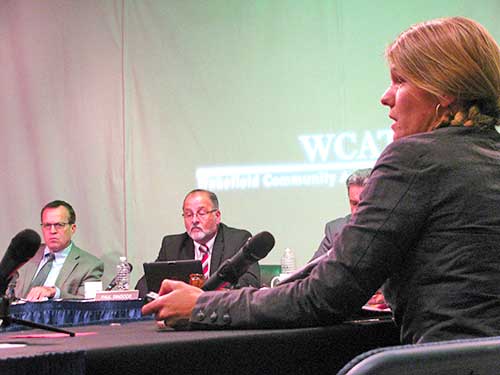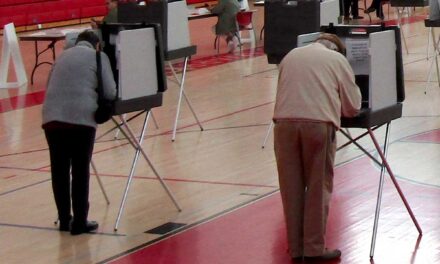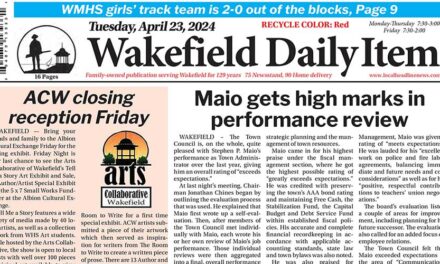Published in the November 1, 2017 edition

CATHERINE DHINGRA didcussed the latest Youth Risk Behavior Survey results with the Board of Selectmen. (Mark Sardella Photo)
By MARK SARDELLA
WAKEFIELD — Members of the Board of Selectmen were disturbed this week to learn that, among local youth, marijuana use, e-cigarette use and bullying have all increased according to the recently released 2017 Youth Risk Behavior Survey of students at Wakefield Memorial High School and the Galvin Middle School.
Catherine Dhingra, the town’s substance abuse prevention coordinator, presented the findings at the board’s meeting this week. A month ago, she shared the same findings with the School Committee (see Sept. 27 Daily Item).
The 2017 YRBS was administered in April 2017 to the WMHS student body (9-12) and the Galvin student body (7th and 8th grade only). The YRBS Survey was developed by the Centers for Disease Control. In 2017 it was also administered as a regional collaborative with the Middlesex League schools thanks to funding from the Lahey Clinic.
The survey highlighted a number of troubling trends, including the fact that vaping/e-cigarette use is rising at “alarming” rates both at WMHS and Galvin. Marijuana use has also increased “significantly” over the past year. Of particular concern is the fact that marijuana use while driving has also increased.
The number of youth reporting they have a trusted adult at WMHS has decreased, while Galvin bullying has increased, and is higher than Middlesex League overall.
The reported rate of past 30-day e-cigarette use at WMHS more than doubled in the past year, from 15.9 percent in 2016 to 34.6 percent in 2017. That number is also much higher than the 23.4 percent rate in the Middlesex League as a whole.
Past 30-day marijuana use at WMHS also spiked in 2017 after showing a gradual drop since 2011. Thirty percent of WMHS students admitted to having used marijuana in the last 30 days, compared to 20 per- cent in 2016. Twenty-five percent of WMHS students also reported having driven after using marijuana, compared to 15.7 percent in the Middlesex League as a whole.
There were also troubling numbers among 7th and 8th graders at the Galvin when it came to past 30-day e-cigarette use. In 2016, 5.2 percent of GMS students reported using e-cigarettes in the past month. But that number nearly doubled to 10.2 percent in 2017. Reported marijuana use by local 7th and 8th graders jumped from 1 percent in 2016 to 4 percent in 2017.
In response to question from the board, Dhingra said that although local vendors are not supposed to sell e-cigarettes or vaping devices to anyone under 21, kids often manage to get them online. Chairman Paul DiNocco noted that there are two or three e-cigarette stores on Albion Street, for a total of four in town. All are within a short distance from the Galvin Middle School and the Boys and Girls Club located in the Americal Civic Center.
Selectman Mehreen Butt noted that at last weekend’s Halloween Spooktacular children’s event, local e-cigarette/vape stores were handing out coupons for their products. She said the she personally was handed three coupons.
Selectman Brian Falvey was particularly dismayed by the rise in marijuana use among youth.
“We’ve voted as a society that this is culturally acceptable, so why would you expect anything other than for our kids to find it to be acceptable too?” Falvey lamented.
Selectman Tony Longo said that he was especially worried about marijuana edibles.
Selectman Ann Santos said that she was particularly troubled by the sexual violence data in the report and some of the things she has heard regarding attitudes among youth. She said that she would contact Dhingra privately.
Selectman Edward Dombroski cited the statistics on local kids drinking and driving as well as the rise in marijuana use, calling the statistics across the board “sobering.” He wanted to know what more the community could do beyond everything that the schools and the Health Department are already doing.
Dhingra said that she would love to see more people as visibly outraged as the selectmen are about these trends and have the courage to speak up when things are not good.
Falvey said that cultivating student role models would probably be more effective than parents just telling kids what they can’t do.
Dhingra agreed. She said that WMHS student leaders will be visiting the Galvin Middle School next month to do workshops for the GMS students. She said that the high school students will be encouraged to wear their sports or band uniforms because that’s what the middle school kids aspire to be.
She also said that parent leaders influencing their peers in a positive way is also a useful approach, rather than “trying to be the cool parent.”
Dombroski wanted to know what it would take to administer the Youth Risk Behavior Survey every year on a regular basis. Dhingra said that the only reason they were able to do the survey in consecutive years (2016 and 2017) this time was due to grant funding from Lahey Health. Dhingra said that due to lack of funding, a return to the every-two-years approach will probably continue.
Dombroski expressed surprise that in an annual budget of $38 million the School Department couldn’t find the $4,000 to $5000 it would take to do the survey every year.
To see Dhingra’s full PowerPoint presentation on the YRBS, go to https://wakefieldwakeup.org/wp-content/uploads/2014/07/2017-Wakefield-YRBS.pdf.




